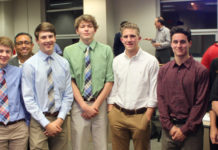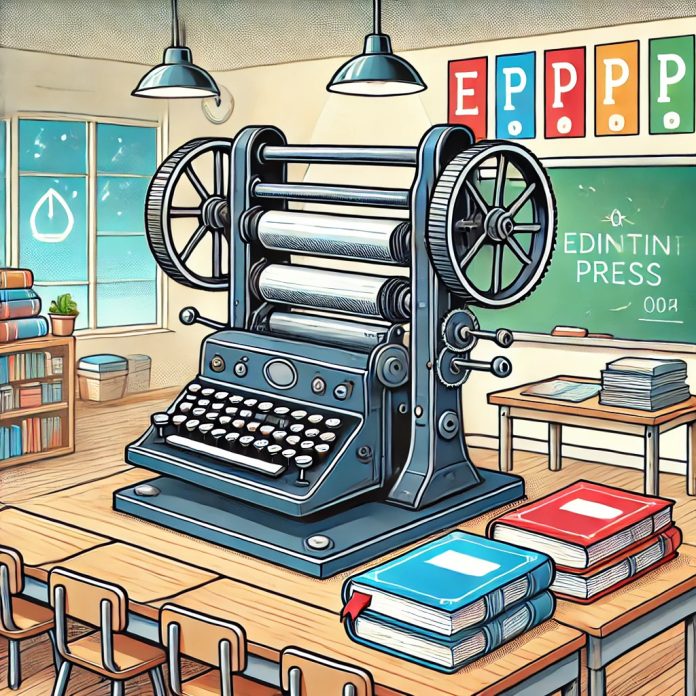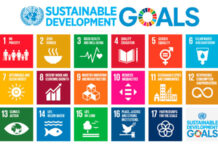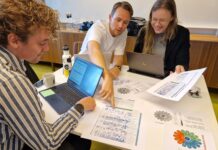If the last chapter was about waking students up from a slumbering existence in a protective classroom through a variety of small-scale approaches, this chapter is about seriously drawing students out into the world outside school, letting them stretch themselves and show the world what they are actually capable of achieving here and now.
Once the first step has been taken, a pleasant descent often begins. This can open up time, courage and energy for more extensive activities with students. This chapter describes eleven different types of activities we encountered in the research, which I consider to be slightly more advanced or otherwise a little more challenging. The positive effects are then often stronger, but it may also require a little more planning or previous experience of value creation on your part as a teacher.
Many of the activities described below can probably also serve as a first step. But since I need to divide the book into different chapters, these eleven types of activities had to come in a separate chapter. How demanding the work will be probably depends very much on how the details are designed and on the possibilities and limitations of each teacher’s unique situation. At the same time, I think that for many teachers it is a bit of a leap to have students run campaigns, produce printed materials for external people, work on different concepts, collaborate internationally or organise a major event with external guests.
Let an external person give a real assignment
Let’s return to the idea of commissioned work. A slightly more advanced version of this is for the teacher to ask an external person to ask the students to help with something. It may seem sly, but it can make a big difference to the students. In fact, it’s no worse than the way in which the prompters discreetly whisper to actors on stage when they forget a line. The illusion persists and can work even if the students realise that the teacher has probably nudged the outsider who asked them for help.
Students have helped many different externals on the initiative of teachers. Architects have been helped to design playgrounds, construction companies have been helped to design the workplaces of the future, theme parks have been helped to come up with fun themes, museums have been helped to build exhibitions, housing companies have been helped to develop better waste management. The list of examples is endless. Such help is often referred to as “live”[1] or “real missions”[2] , and can involve individuals, workplaces or associations. Often it is a company, a public organisation or an association that is helped. But not always. Teachers can also contact individuals who can be persuaded to ask for help privately or at work with various issues they are struggling with. Imagine getting help from thirty creative young people with something you struggle with in your everyday life. I wouldn’t turn it down.
Real missions are a very powerful approach, but there are pitfalls. Students need to feel that they have a reasonable chance to create value for others in real life. They need to get that all-important feedback from those they are trying to create value for, preferably through a real meeting where they get to present their work and then get feedback directly from those who have asked for their help. Best of all, they get to co-create value with externals. The more students who are given the same assignment, the greater the risk that each individual student will not perceive it as real. It can also be perceived as a competition, with one group winning the title of “best solution” and the others feeling like losers.
The teacher also needs to ensure that the link to the curriculum documents is there. With real missions, students take external people’s needs as their starting point rather than the subject knowledge and skills to be learned, which places greater demands on the teacher to be there and link theory to practice.
Let students take the initiative to help adults
I have been an adult for almost thirty years. I have never had a student in a primary or secondary school contact me and ask me if I needed help with anything. This is despite the fact that I have worked on many exciting and knowledge-intensive things in my adult life where I have needed lots of help. Imagine if I had been able to get help for a few months from nearly thirty bumbling creative students on some question I was puzzling over. Maybe with putting into words the beauty of value creation pedagogy, or why truck drivers should practice eco-driving, or what else I might need to learn about old educational philosophers like Dewey, Comenius and Rousseau?
What prevents students from contacting adults and offering them their help? I don’t think it’s the teachers. If teachers had known of a way to combine engaged, inquisitive students with curricular knowledge development, they would probably have resorted to that approach immediately. So now that this and other books on value creation pedagogy have just been finished, I will be sitting here in my office waiting for the phone to ring.
Hi, I’m a student in class 5B. In social studies we are now learning about opinion formation in the media. Do you have a question you would like to reach out with? We can help you. We need to learn about this. What do you say?
Hi, I’m in my second year of high school. I’m currently taking a course in Swedish about writing. You scientists write a lot. Do you have a text you are working on now that we can give constructive criticism on? We need to train our linguistic eye. What do you think?
Hi, I’m in class 2C. We are working with tables in maths. Do you have any tables of numbers you are working with that we can help you with? We can do a check count and make sure you haven’t miscounted. What do you say?
Hi, I’m in the 8th grade. We are currently working on biodiversity. If you have a garden, can we help you with something about your garden’s biodiversity? What do you think?
The list of possible pitches could be as long as you like. But I’d probably turn down the gardening question myself, I don’t have green fingers. Or maybe that’s what I need the most help with. But it’s important for students to be a bit clever in their approach and to be able to take no for an answer – even from those who really should have said yes. Let students think about who is an appropriate contact to make. Then the class can pick up the phone or email and ask ten people if they can help them with something. The question they ask can be both specific and knowledge requirement related, yet open and inviting. This can lead to rewarding win-win partnerships where students learn more in depth by helping an adult with something, and where adults get some help, learn something new and at the same time get to help future adults grow. There’s also an old cardinal rule in sales – ten taps one thanks. It’s perfectly normal to have to make ten contacts to find someone who actually wants help. If you want to make it a little easier, students can call some of their class’ parents. And it certainly doesn’t have to be the case that students call their own parents.
Of course, it is easier for older students to help an adult than for younger ones. But younger students can contribute a lot if given the chance. What’s more, adults find it surprisingly fun to get help from younger students. I don’t know how many times students have expressed surprise at how well they have been received by adults when they have made contact. Adults are also ultra-social.
Let students make videos
Video is a very valuable medium for student value creation. All it takes to get started is a mobile phone and an unpolished idea. Then they can reach billions of people with their videos and try to create value for their viewers in different ways. In one of our research studies, a student in Matfors in Sundsvall made a video about how to draw an eye. Today, that video has over fifty thousand views on Youtube. But students’ videos can also stay in the classroom, and that works well too.
A few years ago I received an email from the teacher Kjell-Ivar Karlsson at Strandenskolan in Dorotea who had heard about my research. He wrote to me about the flipped classroom that has become popular. Teachers film their briefings so that students can watch them at their own pace. Kjell-Ivar instead worked with student flipped classrooms – students filming their presentations so that their classmates can watch them at their own pace. In such a classroom, students get to work as newsreaders, actors, journalists, scriptwriters, vignette musicians, producers of history documentaries, travel writers and, of course, cameramen/women. In English, Swedish and other languages. The films at Strandenskolan are mainly shown in the classroom as a natural part of teaching, rehearsal and peer assessment, but also to parents at development talks and parent meetings.
The approach has been an incredible boost both for Kjell-Ivar and for the students. Students’ motivation to go to school was strengthened, they became better at oral presentations, nobody forgot their homework anymore, their self-esteem was strengthened, more people dared to fail and the class values were greatly enhanced by all the peer assessment. Kjell-Ivar himself had a much more enjoyable job, facilitated assessment and improved relations with the guardians. One parent asked Kjell-Ivar why more teachers don’t work like this. You really have to wonder. I promised Kjell-Ivar I would spread the word about his work, and here I finally got the chance. Go to Dorotea and be inspired!
Let students run campaigns or educate the public
Few students have been more successful in campaigning and public education than Greta Thunberg. By working one day a week to create value on her own initiative, she changed an entire world. Today, she is no longer alone on Fridays, but has been joined by millions of other students.
Those of us who are active in value creation pedagogy like to think of Greta as a prime example of students doing something through activism that really matters, something that astounds the world. Teacher Maria Wiman urges teachers to bring out students’ inner drive and fighting spirit, to “unleash students’ inner Greta’s”.[3] With teachers’ active involvement, we might be able to avoid unexcused absence and instead use the classroom as a base for students to practice their action skills to try to make the world a little better.
Nobody has missed that Greta is angry. Really angry. And that’s something teachers can pick up on. Read students’ emotion lists very carefully. I’m sure you’ll find there the impetus for their space flight towards motivation for schoolwork-moon. Let them campaign and educate the public on the very issues they are angry about and which can be linked to curricula and policy documents. One such issue is, of course, sustainable development, which can easily be linked to any subject in school, not least Science and Mathematics.[4] The students will eventually take over the very planet we adults are in the process of destroying. A perfect flare to awaken dormant inner Gretas. I will return to sustainable development in chapter 9.
So what have students been campaigning about? Well, lots of pressing issues. Child soldiers, energy wastage, oil spillage, littering, discrimination, ill health, cyber bullying, drunk driving, sexually transmitted diseases, child marriage, food waste and much more. All the world’s problems are guaranteed to be enough learning oxygen throughout primary and secondary school, for all students throughout the world. Activism is a chance for students to be part of something that really matters.[5] To work as a whole class towards a meaningful goal that is bigger than oneself and one’s individual development plan. To experience this while still at school.
Let students create printed materials
Seeing your own words in print is a special experience. For me as a researcher, it is a highlight every time I receive a final version of a research article for proofreading. It’s the same old text I’ve been working on for a long time, but in typeset form on paper it’s still a completely different feeling.
A teacher who knew how to harness the power of motivation of the printed word was Célestin Freinet. As early as 1923, he bought his first printing press and installed it in his classroom. His students then printed school newspapers, letters, textbooks and field reports, which they used in class and also sent to friend schools around France and Algeria. According to Freinet, the written word only becomes meaningful when it is used to communicate with others outside the school walls.[6] This is why the printing press was one of the most important and appreciated technical aids in Freinet’s model school in Vence, France.
Freinet was a real IT geek, long before the first computer was even conceived. His passion for information technology was undeniable. He experimented all his life with linography, hectography, typography, printing presses, radio transmitters, tape recorders, film cameras and projectors. Freinet was convinced that schools could not afford to neglect the possibilities that various technological tools could offer teachers and their students.[7] He himself sold printing presses to schools all over France.[8]
In our research, we have seen many examples of students making various printed materials. These include leaflets used in a campaign, brochures explaining different phenomena, posters put up for public education purposes in health centres and other public places, Christmas cards sent to prison inmates, chapter books read aloud to young children, anthologies put together and whole books presented and sold at Sweden’s largest annual book fair in Gothenburg. The effects we see on students who make printed materials are incredibly powerful. They marvel at how well their work is received, their confidence is boosted and they are welded together as a class.
I often get the feeling that I am building on Freinet’s work, both in terms of educational philosophy and information technology. Since 2013, I have been experimenting with a digital tool we built to help teachers track students’ value-creating actions via written reflection, read more in chapter 8 on assessment. I wish more of us school researchers were experimenting with IT tools in the spirit of Freinet. But today’s technology is more complex than in Freinet’s time. It can cost millions to build a single digital technology support for teachers. The company Mobile Stories for example, has had to raise $500k in charitable funding from Google to further develop their publishing tool for students. This is money that traditional research funders don’t hand out, that universities can’t afford, and that private actors rarely charge to their bottom line.[9]
Capturing moments and events in flight
When value creation becomes a bit more established as a mindset and culture among the students in the class, it becomes easier to start new value-creating activities a bit more spontaneously. This can be based on discussions that have taken place in the classroom or out in the community. Something a student has said may have aroused the interest, involvement or outrage of classmates. Perhaps a recent incident reported in the media could be a seed for value creation. However, such unplanned and spontaneous value creation requires both teachers and students to have warmed up, otherwise it can be difficult to get off to a good start.
Many of the examples teacher Maria Wiman in her book Value Creating Learning came about in just this way. The students’ initiatives to try to save a television programme from closure, to educate the public about online hate and to write a magazine about child soldiers were all spontaneous, spur-of-the-moment ideas. An obvious advantage of taking up students’ ideas is that participation is at its peak from the start.
Use a concept or science centre
There are a large number of ready-made concepts that teachers can use in creating value with students. This can certainly be a good way to get more in-depth value creation work underway. Many concepts are very well designed and widely tested, but often also require a relatively high level of time and commitment from both teachers and students.
Some common concepts in Sweden with more or less value-creating elements are Operation Dagsverke by UNICEF, First Lego League, Make Music Matter, Young Scientists and Future Seeds. In Spanish-speaking countries there are concepts such as Junior Achievement – Aprender a Emprender, Empresa Joven Europea.
A closely related phenomenon in Sweden is the nineteen science centres around the country. Some examples are the Technical Museum in Stockholm, Universeum in Gothenburg and Navet in Borås. Many of these activities have historically had a strong focus on educational experimentation and entrepreneurial skills. Science centres often operate at the interface between education, the world of work and the non-profit sector. There is also a culture among their staff of trying new ways of teaching science, technology and mathematics. Student activities often have a focus on enjoyment value for students themselves, with the aim of raising their interest in science, technology and mathematics. Allowing students to create something of value to others has so far rarely been a focus of science centres and therefore represents an opportunity for the future. Some exceptions exist, involving students who are given sharp assignments from companies through science centres in Borlänge and Borås.
Teachers should beware of some risks and pitfalls when it comes to ready-made concepts. They certainly help teachers save a lot of time but often leave less room for students to have an influence on the working process. It is also still rare to find concept developers who know and really work with the basic principles of value creation pedagogy. Many (but not all) of them therefore miss obvious opportunities for genuine value creation by students for others, focus too narrowly on economic value creation and overlook the importance of feedback to students from outsiders face-to-face.
I would like to take this opportunity to encourage both concept designers and science centres to weave more of the three basic principles of value creation pedagogy into their various approaches – (1) students’ value creation for others resulting in genuine interpersonal feedback from outsiders, (2) interaction with real individuals in the world, and (3) fine-grained blend of learning and value creation so that the concepts do not remain isolated phenomena but rather are integrated into regular teaching over longer periods of time. This represents an often untapped opportunity to make a stronger impact of what is already being done in class. Teachers can also help concept makers and science centres to better weave value creation into their teaching. We may be entering an exciting new era as more and more concept designers and science centres, in close collaboration with teachers, take advantage of the three basic principles of value creation pedagogy, so that students can breathe handiness-, social- and creativity oxygen more often during their school days.
Get one or more buddy classes
Let us now return to Freinet. Buddy classes are a good old idea that offers great opportunities for creating value for others. Students can read and give feedback on each other’s texts. They can exchange thoughts, pictures and videos across great distances. But it is also possible to have a buddy class at your own school.
At Freinet’s example school in Vence, students had exchanges with as many as ten classes around France. Twice a week, they sent articles from their class newspaper to one of the ten buddy classes. If it worked in the 1930s, it should be as easy as pie in today’s digitally connected society. In our research, we have also seen examples of buddy class exchanges between a school in Sundsvall and a school in Huddinge.[10] In that case, it was the teachers who initiated a temporary exchange. A buddy class can last anywhere from a few days to several years.
Some tools for finding buddy classes are online resources such as ePals (epals.com), The Nordic Region in Schools (nordeniskolen.org) and eTwinning (etwinning.net) where millions of teachers have connected with each other worldwide. But it’s also possible to contact someone randomly in another school, to look around in your network or to seek contact via social media. The Nordic Region in Schools website gives teachers ten tips on how to make buddy classes work in practice. Keep it simple with a few activities, build strong relationships both between teachers and between students, talk through expectations and have clearly written structures for the work.
Start an international exchange
We live in a digital and global age. Students today are just a click away from the billions of people around the world they can create value for. This means new opportunities for teachers to “bring the world into the classroom and to take the classroom out into the world without physically moving” (Granath & Hahn 2021, s. 19). Through various collaborative projects, teachers and students can seek funding to work together and even meet across national borders. European partners can be found through the Erasmus+ and eTwinning exchange programmes, among others. But how can teachers structure their teaching?
At Gränby School in Uppsala, students had the opportunity to collaborate with students in Germany for three terms through an eTwinning project. They worked together on different themes every month, they presented tasks to each other via big screen, they compared each other’s school systems and they communicated and worked together via different digital tools and apps. Teacher Emelie Hahn sums up the impact in a Swedish book about bringing the world into the classroom (Granath & Hahn 2021, s. 323):
Their understanding of the world around them increased and their cultural competence was strengthened. The students made friends in Germany with whom they also communicated in their free time, which further strengthened their language skills. The lessons were real, which created motivation and engagement – students wanted to learn in order to communicate with their new friends in Germany. The students of the German partner school came to visit for a week.
I shiver of delight when I read the book. This is how every student should learn a new language, and a lot of other knowledge too. How can we even think that students can learn a foreign language without experiencing this kind of cross-border and mutually valuable exchange? Emelie Hahn’s example should be the norm, not the exception, in schools. After all, I experienced this myself when I was in secondary school. Maybe that’s why I became a backwards researcher?
Bring in resources for your project
One way to gain momentum for a value creation project is for students to ask around the community for different types of sponsorship, donations and resource contributions from adults working in different workplaces relevant to the project. Students can be surprisingly successful in getting outside help in various initiatives. If a printed piece needs to be produced, ask a printing company for help with printing. If a dinner needs to be prepared for a charitable cause, ask a food company for help with food supplies. If a radio programme is to be broadcast, ask companies to fund the radio time or, for that matter, the class trip through radio advertising. If a peace magazine students made needs to sell a little better, ask candy companies to donate candy that can be sent along to the buyers. This was how Maria Wiman’s students did it at Edboskolan in Huddinge. They received 135 kilos of sweets from various companies, and were able to spread the word about child soldiers while raising SEK 16,589 for the Red Cross.[11] Just make sure the students are prepared for the fact that selling requires a lot of conversations. Ten taps, one thanks, please.
Also make sure that the sponsorship does not violate ethical principles. Companies that help students should be reputable, free of tax liabilities and operate in a manner consistent with the school’s values. The contribution must be reasonable in relation to the scale of the project and the risk of commercial bias. Gifts may be complementary to, but not a prerequisite for, teaching. It may be useful to draw up a written agreement signed by the headmaster.
The best thing about sponsorship and donations is that suddenly you have unexpected resources that provide rocket fuel for student engagement. And once the help arrives, there’s no turning back. Time to do what you promised your helpers! Be careful what you wish for.
Organise an event
Let’s end this chapter with a real classic – students organising some kind of event. It could be a disco, a theatre performance, a concert or even a festival, a flea market, a sports event, a fair, an art opening, an experience day, or why not an animal festival. Invite an audience, maybe charge for admission. In our research, we have seen students organising science fairs, Nobel Day and of course the classic parents’ evening.
Just make sure that adults don’t do things that students can do perfectly well on their own. Don’t become a curling teacher or curling parent when events are being organised. I’ve seen that too many times in youth sports – perhaps the biggest curling movement in Sweden. There, dedicated parents take care of lots of tasks that children and young people could have done more or less on their own.
[1] Future Seeds calls its material “sharp missions”.
[2] In Trelleborg, sharp assignments are called real cases.
[3] In a Swedish podcast series by Patricia Diaz called På tal om lärande.
[4] See Nelson (2021, s. 42).
[5] Read more about educational activism in Hodson (2014).
[6] Freinet (2018, s. 44).
[7] See Freinet (2018, s. 105–108).
[8] According to Kergel (2020, s. 59).
[9] See Lackéus and Sävetun (2021).
[10] See Lackéus and Sävetun (2016, s. 43 och 51).
[11] Read more in Wiman (2019, s. 36–40).








